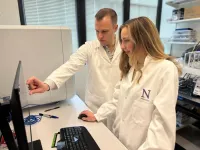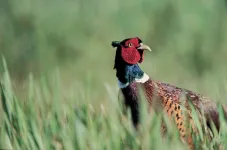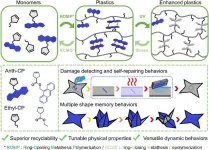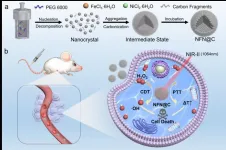(Press-News.org) [Vienna, 06.02.2025]—"In this study, we use the spatial social connections of people within the 50 largest cities in the US to test whether the built environment—in this case, urban highways— is indeed a barrier to social ties, as has long been assumed in urban studies. For the first time, we are also finding quantitatively that this is the case,” explains co-author Sándor Juhász. During his postdoctoral fellowship at the Complexity Science Hub (CSH), Juhász participated in the study.
This barrier effect by urban highways is particularly strong for short distances of less than 5 km (or ca. 3 miles) in all the US cities studied. It only reverses at around 20 km (ca. 12.4 miles) —above this distance, urban highways tend to help connect places within a city, according to the study. “In concrete terms, this means that if two people live on different sides of an urban highway, it is less likely that there will be social contact between them,” says Juhász, who’s now a research fellow at the Corvinus University of Budapest.
“Urban highways, especially those built in the US in the 1950s and 1960s, were entirely geared towards car traffic,” explains co-author Anastassia Vybornova from the IT University of Copenhagen. They were intended to shorten the commute to work and make traveling within the city easier. “But this comes at a price, especially over short distances. If someone wants to cross a multi-lane highway, it takes a lot of effort. So highways connect over long distances, but divide over short ones,” adds Juhász.
Effects Quantified for the First Time
A special feature of this study is that, for the first time, the researchers not only described these barrier effects qualitatively, but also quantified them. To do this, the team, led by the IT University of Copenhagen, combined geographical data with location information from online social networks.
The researchers added a second layer to a city map with streets, rivers and, other geographical features: a social network of 1 million X users (formerly Twitter) from 2013. The nodes of this network represent people's estimated places of residence, while the connections represent their friendships on X within the city.
“The fact that the mutual followerships on X reflect real friendships is of course a highly generalized assumption,” says Juhász. “It is extremely difficult to map social connections at this level of detail. There are currently no comprehensive datasets for such analysis—most, such as public Facebook data, are only aggregated at the zip code level. But to examine the influence of highways, much finer data is needed. It's interesting to see that the barrier effect of urban highways is already detectable in this dataset.”
Cleveland Has the Largest Barrier Effect
The average barrier effect of urban highways is highest in Cleveland, a city with particularly high segregation, according to the results of the study.
“In the US, there is a long tradition of highway construction through densely populated areas, which has led to segregation and a decline in local opportunities,” explains Juhász. “Urban planners often used to decide to build highways in such a way that they cut through large, homogeneous neighborhoods or physically separate different population groups—mostly Black and White communities”.
The best-known example is probably Detroit with the 8 Mile Road. “Our measurements clearly show that there is still less social contact there today than would be the case without the highway,” adds Juhász.
In the US, there were already major programs such as the “Reconnecting Communities” initiative, which invested millions of dollars to make urban infrastructure more socially just. “So the problem was recognized, and there were active policies with increasing budgets. But more importantly, this program—like many others—was stopped by the new US government a few weeks ago,” says Juhász. This makes studies like this one, which show that urban highways have a significant influence on social connectivity, all the more important, according to Juhász.
About the Study
The study “Urban highways are barriers to social ties” by L.M. Aiello, A. Vybornova S. Juhász, M. Szell, and E. Bokányi was published in PNAS (doi: 10.1073/pnas.2408937122).
About CSH
The Complexity Science Hub (CSH) is Europe’s research center for the study of complex systems. We derive meaning from data from a range of disciplines—economics, medicine, ecology, and the social sciences—as a basis for actionable solutions for a better world. Established in 2015, we have grown to over 70 researchers, driven by the increasing demand to gain a genuine understanding of the networks that underlie society, from healthcare to supply chains. Through our complexity science approaches linking physics, mathematics, and computational modeling with data and network science, we develop the capacity to address today’s and tomorrow’s challenges.
END
Urban highways cut opportunities for social relationships, says study
Urban highways are meant to speed up travel and foster connections, but a study shows they reduce social ties within cities, according to a study involving CSH
2025-03-06
ELSE PRESS RELEASES FROM THIS DATE:
Alzheimer’s treatment may lie in the brain’s own cleanup crew
2025-03-06
MEDIA CONTACT: Kristin Samuelson at 847-769-6596 or ksamuelson@northwestern.edu
EMBARGOED FOR RELEASE: 5 a.m. (ET), Thursday, March 6, 2025
Alzheimer’s treatment may lie in the brain’s own cleanup crew
Brain’s immune cells cleared plaques, restored a healthier brain environment in immunized patient brains
Current FDA-approved Alzheimer’s drugs remain controversial, with modest benefits, high cost
First time cutting-edge technique spatial transcriptomics was used on human clinical-trial brains with Alzheimer’s disease
Findings could reshape the future of Alzheimer’s ...
Climate change threatens future of banana export industry
2025-03-06
Climate change is rapidly reducing the ability of banana producers to supply one of our favourite fruits.
New research from the University of Exeter, published in Nature Food, has found it will be economically unsustainable by 2080 for many areas across Latin America and the Caribbean to continue growing bananas for export, because of rising temperatures caused by climate change.
Bananas are a key export crop worth $11 billion (£8.9 billion) annually and are crucial for the economies of many countries. Yet in just over half a century, 60 per cent of the regions currently producing bananas will ...
World’s oldest impact crater found, rewriting Earth’s ancient history
2025-03-06
Curtin University researchers have discovered the world’s oldest known meteorite impact crater, which could significantly redefine our understanding of the origins of life and how our planet was shaped.
The team from Curtin’s School of Earth and Planetary Sciences investigated rock layers in the North Pole Dome — an area of the Pilbara region of Western Australia — and found evidence of a major meteorite impact 3.5 billion years ago.
Study co-lead Professor Tim Johnson, from Curtin University, said the discovery significantly ...
Pledge to phase out toxic lead ammunition in UK hunting by 2025 has failed
2025-03-06
A voluntary pledge made by UK shooting organisations in 2020 to replace lead shot with non-toxic alternatives by 2025 has failed, analysis by Cambridge researchers finds.
The pledge, made in February 2020 by the UK’s nine leading game shooting and rural organisations, aimed to benefit wildlife and the environment and ensure a market for the healthiest game meat food products.
But a Cambridge team, working with the University of the Highlands and Islands, has consistently shown that lead shot was not being phased out quickly enough to achieve ...
Possible foundations of human intelligence observed for the first time
2025-03-06
A study led by Dr. Rodrigo Quian Quiroga, group leader of the Neural Mechanisms of Perception and Memory Research Group at the Hospital del Mar Research Institute, has allowed scientists to observe for the first time how neurons in the human brain store memories independent of context in which they are acquired. Published in Cell Reports, the study confirms that neurons can distinguish objects or people regardless of their context, enabling the formation of higher and more abstract relationships, ...
Breast cancer death rates have stopped going down
2025-03-06
A new paper in the Journal of Breast Imaging, published by Oxford University Press, indicates that breast cancer mortality rates have stopped declining in women older than age 74, and reconfirms that breast cancer mortality rates have stopped falling in women younger than age 40. This finding for older women is new.
Breast cancer is the second leading cause of cancer deaths in American women, with over 42,000 women dying of the disease in 2024. Before 1990, female breast cancer rates had been rising, and breast cancer mortality rates had been flat or increasing. Since 1990 there has been a steady decline ...
Developing zero-waste, sustainable smart polymer materials
2025-03-06
Plastics, which are polymeric materials composed of long chains of small molecules called monomers, are widely used in everyday life and industry due to their lightweight, good strength and flexibility. However, with approximately 52 million tons of plastic waste generated annually, plastic pollution has become a major environmental concern. To address this issue, research efforts have focused on developing sustainable polymeric materials. Unfortunately, most materials developed so far suffer from complex synthesis processes or difficulties in separating them from other polymers during waste disposal.
To overcome these limitations, a research team led by Dr. Tae Ann Kim of the Convergence ...
AI has ‘great potential’ for detecting wildfires, new study of the Amazon rainforest suggests
2025-03-06
A type of Artificial Intelligence that mimics the functioning of the human brain could represent a powerful solution in automatically detecting wildfires, plummeting the time needed to mitigate their devastating effects, a new study finds.
The new technology uses an ‘Artificial Neural Networks’ model that combines satellite imaging technology with deep learning (a subset of Artificial Intelligence (AI) and machine learning).
Findings, published in the peer-reviewed International Journal of Remote Sensing, report a 93% success rate when training the model via a dataset ...
Magnetic catalysts enhance tumor treatment via electronic density regulation
2025-03-06
Recently, a collaborative research team led by Professor WANG Hui and Professor ZHANG Xin from the Hefei Institutes of Physical Science of the Chinese Academy of Sciences, successfully developed a novel carbon-coated nickel ferrite (NFN@C) nanocatalyst with significant potential in cancer therapy.
The results have been published in Advanced Functional Materials.
Cancer therapy has always struggled with targeting tumor cells effectively while minimizing damage to healthy tissue. Traditional treatments like chemotherapy and radiation often have limited precision and serious side effects. This has led to increased ...
Quantum dot discovery for LEDs brings brighter, more eco-friendly displays
2025-03-06
New research by Curtin University has achieved a breakthrough in eco-friendly display technology, creating highly efficient and stable blue quantum dot LEDs (QLEDs) that could power the next generation of televisions, smartphones, VR headsets and energy-efficient lighting - without using toxic heavy metals.
Study author Associate Professor Guohua Jia from Curtin’s School of Molecular and Life Sciences said QLEDs are a futuristic display technology known for their superior brightness, colour accuracy, lifetime and energy efficiency compared to traditional LEDs. However, creating stable and efficient blue QLEDs without toxic materials ...
LAST 30 PRESS RELEASES:
Making lighter work of calculating fluid and heat flow
Normalizing blood sugar can halve heart attack risk
Lowering blood sugar cuts heart attack risk in people with prediabetes
Study links genetic variants to risk of blinding eye disease in premature infants
Non-opioid ‘pain sponge’ therapy halts cartilage degeneration and relieves chronic pain
AI can pick up cultural values by mimicking how kids learn
China’s ecological redlines offer fast track to 30 x 30 global conservation goal
Invisible indoor threats: emerging household contaminants and their growing risks to human health
Adding antibody treatment to chemo boosts outcomes for children with rare cancer
Germline pathogenic variants among women without a history of breast cancer
Tanning beds triple melanoma risk, potentially causing broad DNA damage
Unique bond identified as key to viral infection speed
Indoor tanning makes youthful skin much older on a genetic level
Mouse model sheds new light on the causes and potential solutions to human GI problems linked to muscular dystrophy
The Journal of Nuclear Medicine ahead-of-print tip sheet: December 12, 2025
Smarter tools for peering into the microscopic world
Applications open for funding to conduct research in the Kinsey Institute archives
Global measure underestimates the severity of food insecurity
Child survivors of critical illness are missing out on timely follow up care
Risk-based vs annual breast cancer screening / the WISDOM randomized clinical trial
University of Toronto launches Electric Vehicle Innovation Ontario to accelerate advanced EV technologies and build Canada’s innovation advantage
Early relapse predicts poor outcomes in aggressive blood cancer
American College of Lifestyle Medicine applauds two CMS models aligned with lifestyle medicine practice and reimbursement
Clinical trial finds cannabis use not a barrier to quitting nicotine vaping
Supplemental nutrition assistance program policies and food insecurity
Switching immune cells to “night mode” could limit damage after a heart attack, study suggests
URI-based Global RIghts Project report spotlights continued troubling trends in worldwide inhumane treatment
Neutrophils are less aggressive at night, explaining why nighttime heart attacks cause less damage than daytime events
Menopausal hormone therapy may not pose breast cancer risk for women with BRCA mutations
Mobile health tool may improve quality of life for adolescent and young adult breast cancer survivors
[Press-News.org] Urban highways cut opportunities for social relationships, says studyUrban highways are meant to speed up travel and foster connections, but a study shows they reduce social ties within cities, according to a study involving CSH




